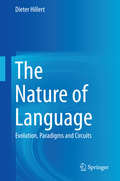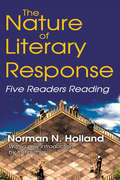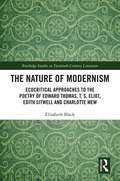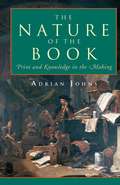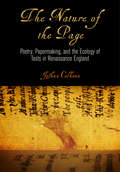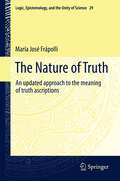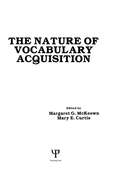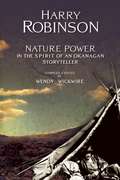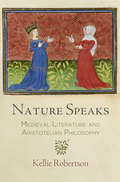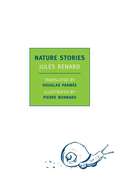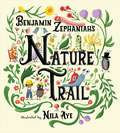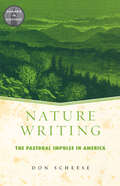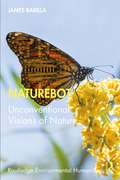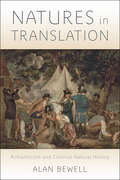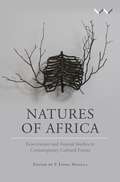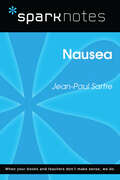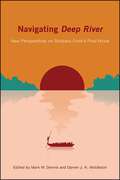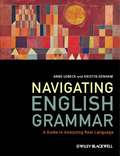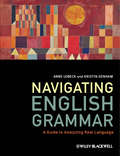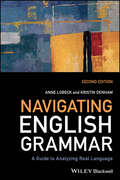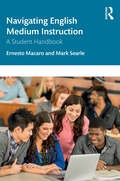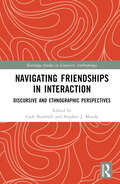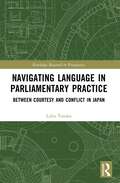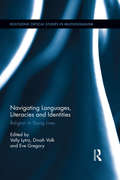- Table View
- List View
The Nature of Language
by Dieter HillertThe Nature of Language addresses one of the most fundamental questions of mankind: how did language evolve, and what are the neurobiological and cognitive foundations of language processing? These questions are explored from different perspectives to discuss the building blocks of language evolution and how they developed in the way they can be found in modern humans. Primarily, neural mapping methods of cognition presented in this research provide extremely valuable data about the neural circuitries that are involved in language processing. Thus, the book explores and illustrates cortical mapping in typical language patterns, but also cortical mapping in atypical populations that fail to process particular language aspects. A neurobiological stance is used to inquire about how language abilities of our species evolved to communicate for the purposes of conveying information such as ideas, emotions, goals, and humor. The evolutionary language model presented builds on the cognitive abilities of our ancestors, and it allows readers to draw a variety of expansive conclusions from that, including the idea that human language as an interface system provides the basis for consciousness.
The Nature of Literary Response: Five Readers Reading
by Clark McPhailIn a rare fusion of literary sensibility with psychological research, Norman N. Holland brings to light important data showing how personality—in the fullest sense of character development and identity—affects the way in which we read and interpret literature. This book will show that readers respond to literature in terms of their own lifestyle, character, personality, or identity. By such terms, psychoanalytic writers mean an individual's characteristic way of dealing with the demands of outer and inner reality. Each new experience develops the style, while the pre-existing style shapes each new experience.The sub-title of this book, Five Readers Reading, reflects the fact that the author, a distinguished literary critic, worked with five student readers, using a battery of psychological tests and extensive interviews to study the ways they reacted to classic short stories by Faulkner, Hemingway, and others. Combining his own interpretation of the stories with his understanding of the readers and their reactions, Holland derives four principles that inform literary response. He then goes on to show how these principles apply, not just to literary response, but to the way personality shapes any experience.The book carries Holland's previous studies of creation and responsive recreation forward to a major theoretical statement. He rejects the artificial idea that one must think of a text (or other event) as separate from its perceivers, illustrating the dynamics by which perceiver and perceived mutually create an experience. For critics and students of the psychology of human behavior, this is challenging and seminal reading.
The Nature of Modernism: Ecocritical Approaches to the Poetry of Edward Thomas, T. S. Eliot, Edith Sitwell and Charlotte Mew (Routledge Studies in Twentieth-Century Literature)
by Elizabeth BlackThis books presents the first extended study of the relationship between British modernist poetry and the environment. Challenging reductive associations of modernism as predominantly anthropocentric in character and urban in focus, the book’s central argument is that within British modernist poetry there is a clear and sustained interest in the natural world which has yet to receive adequate critical attention. Whilst modernist studies continues to emphasize the plurality of the movement and the breadth of voices and concerns within it, the environmental consciousness of modernist literature and its response to changes to human/nature relations following the experience of war and modernity remain largely unexamined. Exploring British modernist poetry from an ecocritical perspective offers a fresh approach to the movement and its context, and produces original readings of both canonical and more marginalized modernist voices. This book opens by discussing the relationship between modernism and ecocriticism and the benefits of creating a dialogue between the two. It then presents new readings of Edward Thomas, T. S. Eliot, Edith Sitwell, and Charlotte Mew that reveal a shared preoccupation with environmental issues and a common desire to find new ways of achieving physical, psychological, and artistic reconnection with nature. Building on the continuing growth of ecocriticism, this book demonstrates how green approaches to modernist studies can produce new insights into both individual poets and the modernist movement as a whole, making it an essential resource for students of modernism, ecocriticism, and early-twentieth-century literature.
The Nature of the Book: Print and Knowledge in the Making
by Adrian JohnsThe Nature of the Book, a tour de force of cultural history, Adrian Johns constructs an entirely original and vivid picture of print culture and its many arenas commercial, intellectual, political, and individual.
The Nature of the Page: Poetry, Papermaking, and the Ecology of Texts in Renaissance England (Material Texts)
by Joshua CalhounIn The Nature of the Page, Joshua Calhoun tells the story of handmade paper in Renaissance England and beyond. For most of the history of printing, paper was made primarily from recycled rags, so this is a story about using old clothes to tell new stories, about plants used to make clothes, and about plants that frustrated papermakers' best attempts to replace scarce natural resources with abundant ones. Because plants, like humans, are susceptible to the ravages of time, it is also a story of corruption and the hope that we can preserve the things we love from decay.Combining environmental and bibliographical research with deft literary analysis, Calhoun reveals how much we have left to discover in familiar texts. He describes the transformation of plant material into a sheet of paper, details how ecological availability or scarcity influenced literary output in the sixteenth and seventeenth centuries, and examines the impact of the various colors and qualities of paper on early modern reading practices. Through a discussion of sizing—the mixture used to coat the surface of paper so that ink would not blot into its fibers—he reveals a surprising textual interaction between animals and readers. He shows how we might read an indistinct stain on the page of an early modern book to better understand the mixed media surfaces on which readers, writers, and printers recorded and revised history. Lastly, Calhoun considers how early modern writers imagined paper decay and how modern scholars grapple with biodeterioration today.Exploring the poetic interplay between human ideas and the plant, animal, and mineral forms through which they are mediated, The Nature of the Page prompts readers to reconsider the role of the natural world in everything from old books to new smartphones.
The Nature of Truth
by Maria Jose FrapolliThe book offers a characterization of the meaning and role of the notion of truth in natural languages and an explanation of why, in spite of the big amount of proposals about truth, this task has proved to be resistant to the different analyses. The general thesis of the book is that defining truth is perfectly possible and that the average educated philosopher of language has the tools to do it. The book offers an updated treatment of the meaning of truth ascriptions from taking into account the latest views in philosophy of language and linguistics.
The Nature of Vocabulary Acquisition
by Margaret G. McKeown Mary E. CurtisFirst published in 1987. Routledge is an imprint of Taylor & Francis, an informa company.
Nature Power
by Wendy Wickwire Harry RobinsonMany of the stories in Okanagan storyteller Harry Robinson's second collection feature the shoo-MISH, or "nature helpers" that assist humans and sometimes provide them with special powers. Some tell of individuals who use these powers to heal themselves; others tell of Indian doctors with the power to heal others. Still others tell of power encounters of various kinds.
Nature Speaks: Medieval Literature and Aristotelian Philosophy (The Middle Ages Series)
by Kellie RobertsonWhat does it mean to speak for nature? Contemporary environmental critics warn that giving a voice to nonhuman nature reduces it to a mere echo of our own needs and desires; they caution that it is a perverse form of anthropocentrism. And yet nature's voice proved a powerful and durable ethical tool for premodern writers, many of whom used it to explore what it meant to be an embodied creature or to ask whether human experience is independent of the natural world in which it is forged.The history of the late medieval period can be retold as the story of how nature gained an authoritative voice only to lose it again at the onset of modernity. This distinctive voice, Kellie Robertson argues, emerged from a novel historical confluence of physics and fiction-writing. Natural philosophers and poets shared a language for talking about physical inclination, the inherent desire to pursue the good that was found in all things living and nonliving. Moreover, both natural philosophers and poets believed that representing the visible world was a problem of morality rather than mere description. Based on readings of academic commentaries and scientific treatises as well as popular allegorical poetry, Nature Speaks contends that controversy over Aristotle's natural philosophy gave birth to a philosophical poetics that sought to understand the extent to which the human will was necessarily determined by the same forces that shaped the rest of the material world.Modern disciplinary divisions have largely discouraged shared imaginative responses to this problem among the contemporary sciences and humanities. Robertson demonstrates that this earlier worldview can offer an alternative model of human-nonhuman complementarity, one premised neither on compulsory human exceptionalism nor on the simple reduction of one category to the other. Most important, Nature Speaks assesses what is gained and what is lost when nature's voice goes silent.
Nature Stories
by Jules RenardThe natural world in all its richness, glimpsed variously in the house, the barnyard, and the garden, in ponds and streams, and at large in the woods and the fields, including old friends like the dog, the cat, the cow, and the pig, along with more unusual and sometimes alarming characters such as the weasel, the dragonfly, snakes of several sorts, and even a whale, not to mention ants in their seeming infinitude and a single humble potato-all these and more are the subjects of what may well be the most deft and delightful book of literary miniatures ever written. In Jules Renard’s world, plants and animals not only feel but speak (one species, the swallow, appears to write Hebrew), and yet, for all the anthropomorphic wit and whimsy the author indulges in, they guard their mystery too. Sly, funny, and touching,Nature Stories, here beautifully rendered into English by Douglas Parmée and accompanied by the wonderful ink-brush images of Pierre Bonnard with which the book was originally published, is a literary classic of inexhaustible freshness.
Nature Trail: A joyful rhyming celebration of the natural wonders on our doorstep
by Benjamin ZephaniahA joyful celebration of nature and the wonder of the world around us by legendary poet and performer Benjamin Zephaniah, one of The Times' top 50 British post-war writers.At the bottom of my garden, there's a hedgehog and a frog,And a lot of creepy-crawlies living underneath a log . . .All around us, from parks to gardens and flowerpots to pavements, there's a world of wonder just waiting to be discovered. Why not look a little closer and see what you find?This joyful celebration of nature reminds us all to take a closer look at the world around us, and enjoy the wonder of nature wherever we find it. Packed with animals and minibeasts galore, this imaginative rhyming text is perfect for reading aloud.
Nature Writing (Genres in Context)
by Don ScheeseFirst published in 2003. Routledge is an imprint of Taylor & Francis, an informa company.
Naturebot: Unconventional Visions of Nature (Routledge Environmental Humanities)
by James BarillaNaturebot: Unconventional Visions of Nature presents a humanities-oriented addition to the literature on biomimetics and bioinspiration, an interdisciplinary field which investigates what it means to mimic nature with technology. This technology mirrors the biodiversity of nature and it is precisely this creation of technological metaphors for the intricate workings of the natural world that is the real subject of Naturebot. Over the course of the book, Barilla applies the narrative conventions of the nature writing genre to this unconventional vision of nature, contrasting the traditional tropes and questions of natural history with an expanding menagerie of creatures that defy conventional categories of natural and artificial. In keeping with its nature writing approach, the book takes us to where we can encounter these creatures, examining the technological models and the biotic specimens that inspired them. In doing so, it contemplates the future of the human relationship to the environment, and the future of nature writing in the 21st century. This book will be of great interest to students and scholars of biomimetics, environmental literary studies/ecocriticism, and the environmental humanities.
Natures in Translation: Romanticism and Colonial Natural History
by Alan BewellUnderstanding the dynamics of British colonialism and the enormous ecological transformations that took place through the mobilization and globalized management of natures.For many critics, Romanticism is synonymous with nature writing, for representations of the natural world appear during this period with a freshness, concreteness, depth, and intensity that have rarely been equaled. Why did nature matter so much to writers of the late eighteenth and early nineteenth centuries? And how did it play such an important role in their understanding of themselves and the world?In Natures in Translation, Alan Bewell argues that there is no Nature in the singular, only natures that have undergone transformation through time and across space. He examines how writers—as disparate as Erasmus and Charles Darwin, Joseph Banks, Gilbert White, William Bartram, William Wordsworth, John Clare, and Mary Shelley—understood a world in which natures were traveling and resettling the globe like never before. Bewell presents British natural history as a translational activity aimed at globalizing local natures by making them mobile, exchangeable, comparable, and representable. Bewell explores how colonial writers, in the period leading up to the formulation of evolutionary theory, responded to a world in which new natures were coming into being while others disappeared. For some of these writers, colonial natural history held the promise of ushering in a "cosmopolitan" nature in which every species, through trade and exchange, might become a true "citizen of the world." Others struggled with the question of how to live after the natures they depended upon were gone. Ultimately, Natures in Translation demonstrates that—far from being separate from the dominant concerns of British imperial culture—nature was integrally bound up with the business of empire.
Natures of Africa: Ecocriticism and animal studies in contemporary cultural forms
by F. Fiona MoollaOne of the first edited volumes to encompass transdisciplinary approaches to a number of cultural forms, including fiction, non-fiction, oral expression and digital media. Environmental and animal studies are rapidly growing areas of interest across a number of disciplines. Natures of Africa is one of the first edited volumes which encompasses transdisciplinary approaches to a number of cultural forms, including fiction, non-fiction, oral expression and digital media. The volume features new research from East Africa and Zimbabwe, as well as the ecocritical and eco-activist 'powerhouses' of Nigeria and South Africa. The chapters engage one another conceptually and epistemologically without an enforced consensus of approach. In their conversation with dominant ideas about nature and animals, they reveal unexpected insights into forms of cultural expression of local communities in Africa. The analyses explore different apprehensions of the connections between humans, animals and the environment, and suggest alternative ways of addressing the challenges facing the continent. These include the problems of global warming, desertification, floods, animal extinctions and environmental destruction attendant upon fossil fuel extraction. There are few books that show how nature in Africa is represented, celebrated, mourned or commoditised. Natures of Africa weaves together studies of narratives - from folklore, travel writing, novels and popular songs - with the insights of poetry and contemporary reflections of Africa on the worldwide web. The chapters test disciplinary and conceptual boundaries, highlighting the ways in which the environmental concerns of African communities cannot be disentangled from social, cultural and political questions. This volume draws on and will appeal to scholars and teachers of oral tradition and indigenous cultures, literature, religion, sociology and anthropology, environmental and animal studies, as well as media and digital cultures in an African context.
Nausea (SparkNotes Literature Guide Series)
by SparkNotesNausea (SparkNotes Literature Guide) by Jean-Paul Sartre Making the reading experience fun! Created by Harvard students for students everywhere, SparkNotes is a new breed of study guide: smarter, better, faster. Geared to what today's students need to know, SparkNotes provides: *Chapter-by-chapter analysis *Explanations of key themes, motifs, and symbols *A review quiz and essay topicsLively and accessible, these guides are perfect for late-night studying and writing papers
Navaratan Vidyarthi Telugu - Telugu Dictionary: నవరతన్ విద్యార్థి తెలుగు - తెలుగు నిఘంటువు
by Dr Jayanti Chakravarthiఈ పుస్తకం లో అన్ని పదాలు వివరణ తెలుగు లో అందించడం జరిగింది.
Navigating Deep River: New Perspectives on Shūsaku Endō's Final Novel
by Mark W. Dennis; Darren J. N. MiddletonIn Navigating Deep River, Mark W. Dennis and Darren J. N. Middleton have curated a wide-ranging discussion of Shūsaku Endō's final novel, Deep River, in which four careworn Japanese tourists journey to India's holy Ganges in search of spiritual as well as existential renewal. Navigating Deep River evaluates and probes Endō's decades-long search to find the words to explain Transcendent Mystery, the difficult tension between faith and doubt, the purpose of spiritual journeys, and the challenges posed by the reality of religious pluralism in an increasingly diverse world. The contributors, including Van C. Gessel who translated Deep River into English in 1994, offer an engaged and patient exploration of this major text in world fiction, and this anthology promises to deepen academic appreciation for Endō, within and beyond the West.
Navigating English Grammar: A Guide to Analyzing Real Language
by Kristin Denham Anne LobeckThe goal of this book is to provide you with tools to analyze the language you hear, speak, read, and write every day, in a variety of registers, genres, and styles, discovering the real grammatical categories and concepts that underlie your own unconscious knowledge of language.
Navigating English Grammar: A Guide to Analyzing Real Language
by Anne Lobeck Kristin DenhamAn engaging and fresh take on the rules and politics of English grammar, written in lively prose. It goes a step further than most books on grammar by providing an overview of the field, with a discussion of historical and current debates about grammar, and how we define, discuss, and approach it. Presents a novel, inquiry-based approach to understanding speakers' unconscious knowledge of English grammar Makes lucid connections, when relevant, with current linguistic theory Integrates language change and variation into the study of grammar Examines historical sources of socially evaluative perceptions of grammar, as 'good' or 'bad', and notions of language authority Provides syntactic explanations for many modern punctuation rules Explores some of the current controversies about grammar teaching in school and the role of Standard English in testing and assessment
Navigating English Grammar: A Guide to Analyzing Real Language
by Anne Lobeck Kristin DenhamEnables students to understand their assumptions and beliefs about the language they use every day In Navigating English Grammar, Anne Lobeck and Kristin Denham offer an engaging introduction to the linguistic study of the structure of English. Teaching basic grammatical analysis through inquiry rather than memorization, this popular textbook encourages students to use their intuitive knowledge of language to make their own discoveries about the grammatical categories add principles of the grammar of English. The book strikes a balance between basic descriptive grammar and syntactic theory, introducing students not only to the structure of English, but also in some cases to why English has the structure it does. Along the way, students discover how English has changed over time, and how it varies from speech community to speech community. Student-friendly chapters contain numerous examples drawn from different varieties of American English, which illustrate how English grammar is a dynamic system: perceptions of one variety as ‘better’ or ‘more correct’ than another, and notions of ‘standard’ and ‘non-standard’ English are socially constructed rather than based on linguistic fact. This edition is fully updated with new examples, new text excerpts from a diverse range of written genres and authors, and completely revised chapters and exercises. The book also includes an entirely new final capstone chapter designed to encourage students to apply what they have learned with more challenging practice exercises. Navigating English Grammar: A Guide to Analyzing Real Language, Second Edition is an excellent textbook for undergraduate courses in English grammar, English linguistics, and language education.
Navigating English Medium Instruction: A Student Handbook
by Ernesto Macaro Mark SearleThis skills-oriented handbook for English Medium Instruction (EMI) learners provides students with a toolbox of strategies and approaches to maximise their performance in their courses.EMI learners are students who are studying an academic subject, other than English itself, through the medium of English. Through a series of carefully designed exercises and awareness-raising tasks showcased in this book, students can develop the skills and strategies they need to optimise their academic performance in the face of considerable academic and language challenges. This accessible text is full of strategies for students to use the English language they already have in order to engage more fully in their academic courses. They will become much more efficient at preparing for, performing in, and reflecting on their classes. The book covers preparing for classes (pre-flight activities); performing in classes (in-flight strategies); and reflecting on classes (after landing).Grounded in the research of EMI teaching and learning and in extensive teacher-training within EMI, this is a valuable resource for any EMI student studying in a university across the world, as well as EMI teachers, EAP/ESP educators, and academic support staff who work with EMI learners.
Navigating Friendships in Interaction: Discursive and Ethnographic Perspectives (Routledge Studies in Linguistic Anthropology)
by Cade Bushnell and Stephen J. MoodyBushnell and Moody present a rich investigation into the navigation of friendships, adopting discursive and ethnographic perspectives to examine Japanese, Chinese, Korean, and English interactional data. Since the definition of friendship is hard to pin down, most sociocultural anthropologists have tended to focus on issues of kinship and descent, while leaving friendship as a residual or interstitial issue. However, this book puts friendship as the central focus and offers unique perspectives from the participants themselves. The interactional work implicated in the accomplishment of making and being friends, and the trials and tribulations of friendship, are both explored through the many detailed analyses showing how the participants navigate the calm and rough waters of friendship in and through their everyday interactions. Researchers, undergraduates, and postgraduate students in the fields of conversation analysis, pragmatics, and other social sciences will benefit from the real-life examples in the book as well as the analysis.
Navigating Language in Parliamentary Practice: Between Courtesy and Conflict in Japan (Routledge Research in Pragmatics)
by null Lidia TanakaTanaka explores the language used in Japanese parliamentary interactions to shed light on the use of language as a tool by politicians to convince, negotiate, persuade, as well as deliver aggression and criticism. By looking at the speech of politicians in the parliament of Japan, Tanaka demonstrates the unbreakable link between language and politics.Despite the association of Japan as a society in which linguistic politeness is paramount, Tanaka highlights the many examples of impoliteness in parliament and illustrates the idea that Japanese parliamentarians use language strategically to accomplish their political agenda. Analysis of questions and answers in committee meetings demonstrate that regardless of which party they belong to, those in opposition use the most antagonistic strategies. The book also shows the ways in which politicians deliver face-attacks and demonstrates that impoliteness can be delivered without insults or open aggression, using extremely polite language, honorifics, or sarcasm and irony.Lastly, the book also reveals that face-attacks are sent by members of both the government and opposition. As a book that explores the commonly overlooked phenomenon of impoliteness in Japan in the context of parliamentary interactions, it is a valuable resource for researchers and academics in the field of pragmatics and discourse analysis as well as a viable resource for undergraduate and graduate students.
Navigating Languages, Literacies and Identities: Religion in Young Lives (Routledge Critical Studies in Multilingualism)
by Eve Gregory Vally Lytra Dinah VolkNavigating Languages, Literacies and Identities showcases innovative research at the interface of religion and multilingualism, offering an analytical focus on religion in children and adolescents’ everyday lives and experiences. The volume examines the connections between language and literacy practices and social identities associated with religion in a variety of sites of learning and socialization, namely homes, religious education classes, places of worship, and faith-related schools and secular schools. Contributors engage with a diverse set of complex multiethnic and religious communities, and investigate the rich multilingual, multiliterate and multi-scriptal practices associated with religion which children and adolescents engage in with a range of mediators, including siblings, peers, parents, grandparents, religious leaders, and other members of the religious community. The volume is organized into three sections according to context and participants: (1) religious practices at home and across generations, (2) religious education classes and places of worship and (3) bridging home, school and community. The edited book will be a valuable resource for researchers in applied linguistics, linguistic anthropology, socio-linguistics, intercultural communication, and early years, primary and secondary education.
